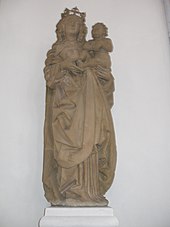Assumption of Mary (Schuttern)
The Roman Catholic parish church of the Assumption of Mary is a repeatedly rebuilt, essentially Baroque hall church with a few Romanesque components in the Schuttern von Friesenheim district in the Ortenau district in Baden-Württemberg . She was formerly the monastery church of the former Benedictine - monastery Schuttern and now belongs to the parish of St. Lawrence Friesenheim in the deanery Lahr of the Roman Catholic Archdiocese of Freiburg. Excavations revealed extensive remains of the monastery buildings, some of which date back to the 7th century, including the oldest floor mosaic in Germany.
Building history
The earliest documented church building and a grave chapel to the west were built in the remains of the wall of a Roman estate. A second, larger church with a semicircular apse already existed before the introduction of the Benedictine rule by Pirminius around the year 750. Around 800 a larger hall church with an atrium and axial alignment with the cross-shaped grave chapel in the west was built; the exam area followed in the north . The Carolingian building was destroyed in 1153, after which a three-aisled cruciform basilica with just closed eastern parts was built, the choir of which was consecrated in 1268 and which was completed around 1360. Above the floor mosaic was around 1290 at Lettner a grave chapel, called Offo - Mausoleum built.
In the 18th century, the entire monastery was expanded to resemble a baroque residence with a courtyard and extensive parks.
The results of the archaeological excavations and the floor mosaic can be viewed under the church. The fragmentary, once circular floor mosaic was laid over a saint's or donor's grave and shows depictions of the sacrifice of Cain and Abel as well as Cain's fratricide and an inscription. The mosaic is the oldest floor mosaic in Germany; its date is controversial, it could have originated in the Ottonian period or in the early 12th century.
The monastery church contains fragments of the Romanesque buildings in its foundation walls. The tower was rebuilt in 1722 and the facade was redesigned, with large parts of the Romanesque vestibule being retained or newly clad. In the years 1767–1771 the nave was rebuilt on a cross-shaped floor plan with a crossing dome by Joseph Michael Schnöller . The building was rebuilt in 1821 and 1837. After it was destroyed by fire in 1853, where the roofs, the ceilings and the interior were damaged, it was restored by Friedrich Theodor Fischer in 1855–1857 , with only the wall structure of the baroque church being retained and the tower being given a new helmet has been. A simplistic renovation was carried out in 1913 by Friedrich Ostendorf . The only remaining part of the former monastery building is today's rectory.
architecture
The four-storey facade tower made of red sandstone, enriched with sculptures, is designed in the strict formal language of the French Baroque. The first floor of the tower is included in the vestibule. The portal from 1767 is flanked by Doric double columns with rustique rings , above which a Doric triglyph frieze is arranged, which extends around the whole building. Above the portal is a cartouche of the coat of arms of Abbot Karl Vogel. Figures of the monastery founder Offo and the innovator Emperor Heinrich II are arranged on the balustrade . The outer walls are lively, the ends of the choir and transept are concave and convex. The sacristy is located behind the main altar .
The Romanesque vestibule under the tower is vaulted with a groin, in the west and south walls masonry with remains of colored paint is included. The nave is a single-nave hall with a double pilaster structure , which was formerly provided with a circumferential gallery. The beamed ceiling above a surrounding cornice with stucco profiles completes the space.
Furnishing
Today's equipment is characterized by the interior renovation from 1977, during which the interior was redesigned while retaining the classicist framework from 1838. The high altarpiece shows the Assumption of Mary and was painted by Josef Melling in 1838. The side altar leaves show Mary with Child and a crucifixion and were created by Melling around 1778. Two former side altar leaves from 1770 with depictions of Saints Sebastian and Vitus are also works by Melling. A painting by Franz Joseph Stöber from 1771 shows the Ascension of St. Benedict.
A Madonna made of yellow sandstone is a work by Strasbourg from around 1480. A crucifix with a finely worked body is a work from around 1760. A coat of arms stone by Abbot Konrad Frick dates back to 1528. Other epitaphs and coat of arms stones by abbots from the 18th century Century are also preserved.
literature
- Georg Dehio : Handbook of the German art monuments. Baden-Württemberg II: The administrative districts of Freiburg and Tübingen. Deutscher Kunstverlag, Munich / Berlin 1997, ISBN 3-422-03030-1 , pp. 654–656.
Web links
Coordinates: 48 ° 22 ′ 55 ″ N , 7 ° 51 ′ 9 ″ E




